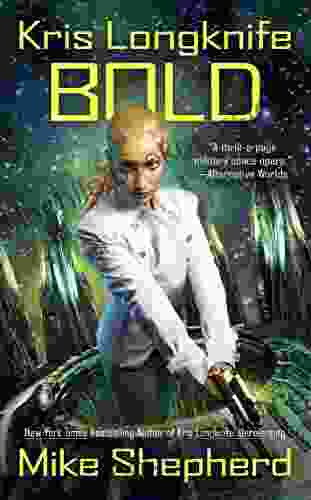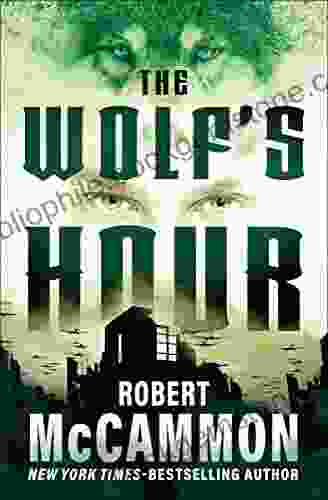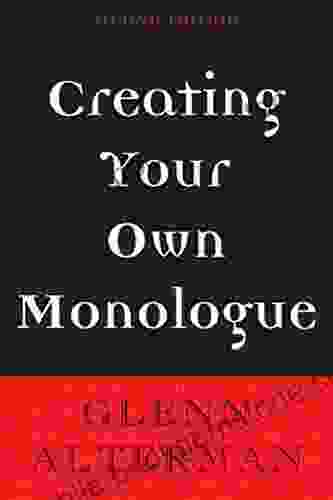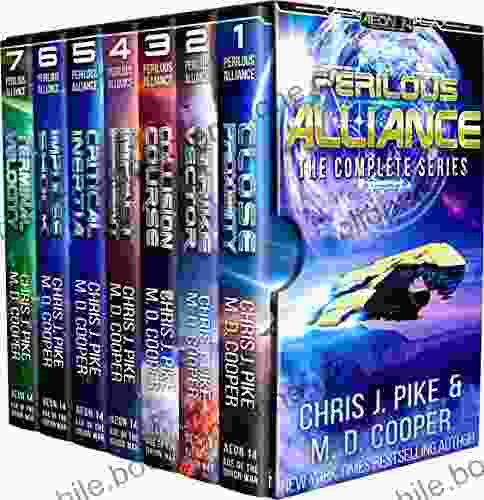Creating Your Own Monologue: A Comprehensive Guide by Glenn Alterman

In the realm of acting, the monologue stands as a powerful tool for expression, transformation, and connection with audiences. Whether it's a heart-wrenching soliloquy or a witty repartee, a well-crafted monologue has the ability to captivate, inspire, and leave a lasting impression.
While many actors may find themselves drawn to performing monologues from established plays or films, there's an undeniable allure in creating your own. Not only does it offer the freedom to explore unique characters and stories, but it also empowers you to develop your voice as an artist and create something truly personal and meaningful.
4 out of 5
| Language | : | English |
| File size | : | 893 KB |
| Text-to-Speech | : | Enabled |
| Screen Reader | : | Supported |
| Enhanced typesetting | : | Enabled |
| Word Wise | : | Enabled |
| Print length | : | 389 pages |
In this comprehensive guide, award-winning actor, director, and acting coach Glenn Alterman shares his insights and techniques for crafting your own compelling monologues. From character development to structure and performance, Alterman provides a step-by-step approach that will guide you through the process of creating a monologue that resonates with both you and your audience.
Step 1: Character Development
At the heart of every captivating monologue lies a well-developed character. Here are some key considerations to help you create a character that is both believable and relatable:
- Who is your character? Consider their name, age, background, occupation, and personality traits. What makes them unique and memorable?
- What are their motivations? What drives them to act and speak the way they do? What do they desire, and what obstacles stand in their way?
- What is their conflict? Every good monologue revolves around a central conflict or dilemma that the character must grapple with. This could be an internal struggle, an external obstacle, or a combination of both.
- What is their voice? How does your character speak? Do they use formal or informal language? Are there any particular quirks or mannerisms that define their speech?
Step 2: Structure
Once you have a clear understanding of your character, it's time to consider the structure of your monologue. While there is no set formula, following a basic three-part structure can help you create a well-paced and satisfying monologue:
- : Begin with an attention-grabbing hook that introduces your character and establishes the setting. Provide essential information about the character's situation and conflict.
- Rising Action: Gradually build the tension and stakes of the conflict. Explore your character's thoughts, feelings, and reactions as they navigate their challenges.
- Climax: The turning point of the monologue where your character confronts the core of their conflict. This can be a moment of revelation, decision, or transformation.
- Falling Action: The aftermath of the climax where the character reflects on their actions and the consequences of their decisions.
- Resolution: The monologue ends with a sense of closure or resolution. The character may have gained a new understanding or perspective, or they may have found a solution to their conflict.
Step 3: Writing
With your character and structure in place, it's time to put pen to paper and craft the words of your monologue. Here are a few tips to help you capture the essence of your character and create a compelling performance:
- Write in your character's voice: Use language and expressions that are true to your character's personality and background. Avoid using generic or overly formal language.
- Use sensory details: Appeal to your audience's senses by incorporating vivid descriptions of sights, sounds, smells, tastes, and textures. This will help them connect with your character on a deeper level.
- Create a rhythm: Pay attention to the rhythm and flow of your language. Use a variety of sentence structures and avoid monotony.
- Revise and refine: Once you have a draft, take some time to step away from it and return later with fresh eyes. Make necessary revisions, tighten up your language, and ensure that your monologue is clear, concise, and impactful.
Step 4: Performance
The final step is to bring your monologue to life through performance. Here are some techniques to help you deliver a captivating and memorable performance:
- Embody your character: Step into the shoes of your character and connect with their emotions and experiences. Physicalize their actions and gestures to create a believable performance.
- Use your voice effectively: Modulate your voice to express the character's thoughts and feelings. Vary your pitch, volume, and tempo to add depth and nuance to your performance.
- Make eye contact: Engage with your audience by making eye contact. This helps to create a personal connection and draws them into your monologue.
- Find your focus: Decide on a focal point for your monologue. This could be a specific object, person, or memory that your character is addressing.
- Practice, practice, practice: Rehearse your monologue repeatedly to ensure that you are comfortable with the material and can deliver it with confidence.
Creating your own monologue is a challenging but rewarding endeavor that can help you grow as an actor and an artist. By following the steps outlined in this guide, you can develop a monologue that is both personally meaningful and engaging for your audience.
Remember that the most compelling monologues are those that are rooted in authenticity and truth. Don't be afraid to draw inspiration from your own experiences and emotions. By infusing your monologue with your own unique perspective, you can create a piece that resonates with audiences on a profound level.
So take the time to explore, experiment, and embrace the creative process. With dedication and practice, you can craft a monologue that will leave a lasting impression and inspire your audience to see the world through new eyes.
4 out of 5
| Language | : | English |
| File size | : | 893 KB |
| Text-to-Speech | : | Enabled |
| Screen Reader | : | Supported |
| Enhanced typesetting | : | Enabled |
| Word Wise | : | Enabled |
| Print length | : | 389 pages |
Do you want to contribute by writing guest posts on this blog?
Please contact us and send us a resume of previous articles that you have written.
 Best Book
Best Book Page Flip
Page Flip Bookshelf
Bookshelf Literary loom
Literary loom Chapter
Chapter Bookish
Bookish PageTurner
PageTurner Bibliophile
Bibliophile Story
Story Inkwell
Inkwell Bookworm
Bookworm Labyrinth
Labyrinth Plot Twist
Plot Twist Prose
Prose Paperback
Paperback Storyteller
Storyteller Sanctuary
Sanctuary Fiction
Fiction Reading
Reading Chronicle
Chronicle Read
Read J G Heck
J G Heck Lucy Worsley
Lucy Worsley Timothy Ellis
Timothy Ellis K Stephen Prince
K Stephen Prince Lisa Mulcahy
Lisa Mulcahy Robert Sinnerbrink
Robert Sinnerbrink Jen Turano
Jen Turano Christopher R Cox
Christopher R Cox H Beam Piper
H Beam Piper Tu Ilape Vimahi
Tu Ilape Vimahi Warren Olson
Warren Olson S L Rowland
S L Rowland The Dancing Pages Publishing House
The Dancing Pages Publishing House Robert Shufflebotham
Robert Shufflebotham Ja Nese Dixon
Ja Nese Dixon J Susan Corley
J Susan Corley Hannah Hinchman
Hannah Hinchman Rick Steves
Rick Steves Gail Pallin
Gail Pallin Margaret Randall
Margaret Randall Bianca Del Rio
Bianca Del Rio January Bell
January Bell Nikki Mcclure
Nikki Mcclure Randolph Lalonde
Randolph Lalonde John La Farge
John La Farge Zondervan
Zondervan Jonathan P Brazee
Jonathan P Brazee Oscar Wilde
Oscar Wilde Mike Ashley
Mike Ashley Julien Blanc Gras
Julien Blanc Gras Lawrence Grobel
Lawrence Grobel Jenefer Robinson
Jenefer Robinson Roger Housden
Roger Housden George Kubler
George Kubler Helen Cates
Helen Cates Greater Than A Tourist
Greater Than A Tourist Mona Golabek
Mona Golabek Jeremy Hicks
Jeremy Hicks Viola Grace
Viola Grace Rachel Baker
Rachel Baker Renae Anderson
Renae Anderson Martina Nohl
Martina Nohl Polly Mckenna Cress
Polly Mckenna Cress Heidi Moksnes
Heidi Moksnes Harriet Beecher Stowe
Harriet Beecher Stowe Gianni Simone
Gianni Simone Catharine Slade Brooking
Catharine Slade Brooking Kit Thornton
Kit Thornton Tiffany Jenkins
Tiffany Jenkins Sydney L Iaukea
Sydney L Iaukea Jay Roeder
Jay Roeder Remy Stern
Remy Stern Marla Day Fitzwater
Marla Day Fitzwater Gail Thorell Schilling
Gail Thorell Schilling Kim Brown Seely
Kim Brown Seely Anne Marie Paquet Deyris
Anne Marie Paquet Deyris Pat Spooner
Pat Spooner Lisa Dines
Lisa Dines Jeanine Kitchel
Jeanine Kitchel Maxwell Farmer
Maxwell Farmer Susan Hardman Moore
Susan Hardman Moore Victoria Abbott Riccardi
Victoria Abbott Riccardi Nathan Mccall
Nathan Mccall Dallas Shaw
Dallas Shaw Richard Dunlop
Richard Dunlop Jim Gertz
Jim Gertz Jessica Pan
Jessica Pan Robert Mads Anderson
Robert Mads Anderson Iris Murdoch
Iris Murdoch Skye Mackinnon
Skye Mackinnon Rick Partlow
Rick Partlow Leo Tolstoy
Leo Tolstoy Malcolm C Salaman
Malcolm C Salaman Luke Sullivan
Luke Sullivan Megan Wells
Megan Wells Candice Lau
Candice Lau Philip Steadman
Philip Steadman David Leddick
David Leddick Paul Wells
Paul Wells Diz White
Diz White Masakazu Ishikawa
Masakazu Ishikawa Jamie Davis
Jamie Davis Lingo Mastery
Lingo Mastery Rochelle Alers
Rochelle Alers Helen Birch
Helen Birch Kimberla Lawson Roby
Kimberla Lawson Roby George W Bush
George W Bush Jan Steinbright
Jan Steinbright Hal Rubenstein
Hal Rubenstein Robert Asprin
Robert Asprin Sam Kashner
Sam Kashner Yaakov Yanky Greenspan
Yaakov Yanky Greenspan Kayla Machine
Kayla Machine Gayle Rosengren
Gayle Rosengren Jennifer J Baumgartner
Jennifer J Baumgartner Indy Quillen
Indy Quillen Jeanne Cooper
Jeanne Cooper Rebecca Zanetti
Rebecca Zanetti Katie Dowe
Katie Dowe Heather D Ward
Heather D Ward Kurt Meissner
Kurt Meissner Gregory Maguire
Gregory Maguire N Scott Momaday
N Scott Momaday Steven D Wolf
Steven D Wolf Jack Higgins
Jack Higgins Gary W Gallagher
Gary W Gallagher Joanie Holzer Schirm
Joanie Holzer Schirm Peter Canellos
Peter Canellos Nick Webb
Nick Webb Sandra A Krasovec
Sandra A Krasovec Gail Morin
Gail Morin Stephen Malins
Stephen Malins Bella Blair
Bella Blair Joseph Heywood
Joseph Heywood Margo Bond Collins
Margo Bond Collins Scott Lunt
Scott Lunt Gil Mcneil
Gil Mcneil Blue Knight
Blue Knight Wendy Hollender
Wendy Hollender Meriel Thurstan
Meriel Thurstan Giannalberto Bendazzi
Giannalberto Bendazzi Helen Burstyn
Helen Burstyn E Train Learning
E Train Learning Lee Summers
Lee Summers Maksim Goldenshteyn
Maksim Goldenshteyn Jay A Stout
Jay A Stout Jennifer D Walker
Jennifer D Walker James Fox
James Fox Octavia E Butler
Octavia E Butler Rosie Rosenzweig
Rosie Rosenzweig Robert O Harder
Robert O Harder S L Giger
S L Giger Robin Landa
Robin Landa Tom Wheeler
Tom Wheeler David Schwartz
David Schwartz Viktorija Todorovska
Viktorija Todorovska Mary E Davis
Mary E Davis Nathan Johnson
Nathan Johnson Luigi Lanzi
Luigi Lanzi Karen Taborn
Karen Taborn Rinoz
Rinoz Grant Fuller
Grant Fuller Winston S Churchill
Winston S Churchill Bradford Bates
Bradford Bates Yingjin Zhang
Yingjin Zhang Kyle Kirrin
Kyle Kirrin Simon Proudman
Simon Proudman Marie D Jones
Marie D Jones Grace Lee Boggs
Grace Lee Boggs Jaquavis Coleman
Jaquavis Coleman Jonathan White
Jonathan White Olivia Gaines
Olivia Gaines Steve Cohen
Steve Cohen Robert Farris Thompson
Robert Farris Thompson Riley Sager
Riley Sager Tayari Jones
Tayari Jones Tabakmann
Tabakmann Simon Tam
Simon Tam Patrick Leigh Fermor
Patrick Leigh Fermor James Willard Schultz
James Willard Schultz Judith Pearson
Judith Pearson Sam Gennawey
Sam Gennawey Thomas A Kelly
Thomas A Kelly Debra Gwartney
Debra Gwartney Lucy Grealy
Lucy Grealy Sharon C Cooper
Sharon C Cooper M S Holm
M S Holm Shari Lapena
Shari Lapena Tilda Balsley
Tilda Balsley Lou Schreiber
Lou Schreiber Jim Carpenter
Jim Carpenter Paul Theroux
Paul Theroux R L Giddings
R L Giddings W Michael Gear
W Michael Gear Billy Pegram
Billy Pegram Ilka Hammer
Ilka Hammer Mickey Zucker Reichert
Mickey Zucker Reichert Kimberly Brooks
Kimberly Brooks Jon Nelson
Jon Nelson Liz Scotta
Liz Scotta Gunnar Staalesen
Gunnar Staalesen Sam Magavern
Sam Magavern Saxon Andrew
Saxon Andrew Roger Kimball
Roger Kimball Black Rose
Black Rose Roland Betancourt
Roland Betancourt Lyn Barrett
Lyn Barrett Sonora Carver
Sonora Carver Max Wilk
Max Wilk Simu Liu
Simu Liu B V Larson
B V Larson Grey King
Grey King Kimberly A Whitler
Kimberly A Whitler Piper Kerman
Piper Kerman Marilyn Grant
Marilyn Grant Werner Stejskal
Werner Stejskal Matt Hranek
Matt Hranek Bill Bryson
Bill Bryson Gary Greene
Gary Greene Manny Serrato
Manny Serrato Hans Von Trotha
Hans Von Trotha Helen Wilkie
Helen Wilkie Neil Gaiman
Neil Gaiman J B Turner
J B Turner George H Gisser
George H Gisser Ta Nehisi Coates
Ta Nehisi Coates Nicole Falls
Nicole Falls Judy Cook
Judy Cook Jen Carter
Jen Carter John Lewis
John Lewis Susan Donnell
Susan Donnell John Muir Laws
John Muir Laws Harry Bernstein
Harry Bernstein J Pal
J Pal Unique Journal
Unique Journal Jimmy Clay
Jimmy Clay Richard Poulin
Richard Poulin Gina Dejesus
Gina Dejesus General
General Thomas Wolf
Thomas Wolf Ian Olio
Ian Olio Sujatha Gidla
Sujatha Gidla Brenda Cooper
Brenda Cooper Marcel Proust
Marcel Proust M G Herron
M G Herron M Angela Sanders
M Angela Sanders Greg Montego
Greg Montego Harlan Hogan
Harlan Hogan Mark Bergin
Mark Bergin Michael Z Williamson
Michael Z Williamson Laird Barron
Laird Barron Brian Patton
Brian Patton Terry Harrison
Terry Harrison Ben Philippe
Ben Philippe Maggie March
Maggie March H G Wells
H G Wells Christopher Butler
Christopher Butler Henry Warren
Henry Warren Tom Kidd
Tom Kidd Tobie S Stein
Tobie S Stein George R R Martin
George R R Martin Paul Levitz
Paul Levitz Joanne Sharpe
Joanne Sharpe Roxanne Dunbar Ortiz
Roxanne Dunbar Ortiz Robert Elms
Robert Elms Colin Thubron
Colin Thubron Justine Cowan
Justine Cowan Shantanu Naidu
Shantanu Naidu Susan Zwerman
Susan Zwerman Gregg Kreutz
Gregg Kreutz Gerald M Kilby
Gerald M Kilby Gav Thorpe
Gav Thorpe Roger Winter
Roger Winter Mark Doty
Mark Doty Gordon Allard
Gordon Allard Ivan Margolius
Ivan Margolius Geoffrey Corfield
Geoffrey Corfield Syd Field
Syd Field Lucius Shepard
Lucius Shepard Michael Oren Fitzgerald
Michael Oren Fitzgerald James D Keyser
James D Keyser Henry Hongmin Kim
Henry Hongmin Kim Tw Robinson
Tw Robinson M D Cooper
M D Cooper Greg Simonds
Greg Simonds Ruth Collis
Ruth Collis Julien Gorbach
Julien Gorbach Theodora Goss
Theodora Goss Shimon Redlich
Shimon Redlich Jonathan Chapman
Jonathan Chapman Joseph Sheppard
Joseph Sheppard Karin Slaughter
Karin Slaughter Megan Fairchild
Megan Fairchild Sara Ivy Hill
Sara Ivy Hill Sallie Ketcham
Sallie Ketcham Sara El Sayed
Sara El Sayed Len Lawson
Len Lawson Kal Wagenheim
Kal Wagenheim Michael Hulse
Michael Hulse Judy Batalion
Judy Batalion Thomas Dublin
Thomas Dublin Lucy Coleman
Lucy Coleman Michael Cawood
Michael Cawood Gubba
Gubba Dima Zales
Dima Zales M K Eidem
M K Eidem Andreas Marks
Andreas Marks H Robert Charles
H Robert Charles Robert Charles Wilson
Robert Charles Wilson Gayle Bird
Gayle Bird Leigh Bardugo
Leigh Bardugo Gb Tran
Gb Tran Giuseppe Leonardi
Giuseppe Leonardi Vanja Hamzic
Vanja Hamzic Leslie J Sherrod
Leslie J Sherrod Patrick Lange
Patrick Lange Joyce Maynard
Joyce Maynard Gianrico Carofiglio
Gianrico Carofiglio Carl Weber
Carl Weber Morris Rossabi
Morris Rossabi Glen Gavin
Glen Gavin Rebekah J Kowal
Rebekah J Kowal Jennifer Worth
Jennifer Worth Heather Murdock
Heather Murdock Robert Mccammon
Robert Mccammon Gloria Fossi
Gloria Fossi Tasha Oren
Tasha Oren George Mather
George Mather Jan Strickland
Jan Strickland Peter F Hamilton
Peter F Hamilton Sarah Cortez
Sarah Cortez Carolyn Phillips
Carolyn Phillips Jonathan Brooks
Jonathan Brooks Morr Meroz
Morr Meroz Robert Kunstaetter
Robert Kunstaetter Dr Will Taegel
Dr Will Taegel Ian King
Ian King Greg Iles
Greg Iles Lizzy Bequin
Lizzy Bequin Jayne Shrimpton
Jayne Shrimpton Grif Stockley
Grif Stockley Will Jordan
Will Jordan Guisela Latorre
Guisela Latorre Gabriella Guglielminotti Trivel
Gabriella Guglielminotti Trivel Ginger Booth
Ginger Booth Shameek Speight
Shameek Speight William A Kappele
William A Kappele Peter Hopkirk
Peter Hopkirk Rich Polanco
Rich Polanco Nathaniel Flakin
Nathaniel Flakin Sarah Sofia Granborg
Sarah Sofia Granborg Jerry Yarnell
Jerry Yarnell Sunil Tanna
Sunil Tanna Kerry Duncan
Kerry Duncan K Kris Loomis
K Kris Loomis J A Rogers
J A Rogers Tetsuko Kuroyanagi
Tetsuko Kuroyanagi Kathleen James Chakraborty
Kathleen James Chakraborty Jan V White
Jan V White Cathy Johnson
Cathy Johnson Liz Lerman
Liz Lerman Heidi Ardizzone
Heidi Ardizzone Helena Hunt
Helena Hunt Paris Permenter
Paris Permenter Gordon Doherty
Gordon Doherty Ian K Smith
Ian K Smith Kristal Norton
Kristal Norton Harold Speed
Harold Speed Gennaro Contaldo
Gennaro Contaldo David Rapp
David Rapp Bob Spitz
Bob Spitz Rachel Schreiber
Rachel Schreiber Simone Edwards
Simone Edwards Joanne Fluke
Joanne Fluke Henry Bond
Henry Bond Haidee Jo Summers
Haidee Jo Summers Garner Simmons
Garner Simmons Helena Reckitt
Helena Reckitt Janwillem Vandewetering
Janwillem Vandewetering Bradford Pearson
Bradford Pearson Oleg Senkov
Oleg Senkov Jen Finelli
Jen Finelli Tyler Farnham
Tyler Farnham Karen Traviss
Karen Traviss Stephen Fraser
Stephen Fraser Godfree Roberts
Godfree Roberts Garance Dore
Garance Dore Thomas R Lindlof
Thomas R Lindlof Cj Fentiman
Cj Fentiman Nancy J Morris
Nancy J Morris Jonathan Nevair
Jonathan Nevair Keisha J
Keisha J Tom Clancy
Tom Clancy John L Williams
John L Williams H Peter Alesso
H Peter Alesso Ben Box
Ben Box Thomas Lockwood
Thomas Lockwood Hannu Rajaniemi
Hannu Rajaniemi Larry Schroeder
Larry Schroeder Mimi Kwa
Mimi Kwa Vine Aduara
Vine Aduara Clayton M Rines
Clayton M Rines John Canemaker
John Canemaker Rosanne Knorr
Rosanne Knorr Gary Troia
Gary Troia Eden Robinson
Eden Robinson Jonathan Ned Katz
Jonathan Ned Katz Jerry Shepard
Jerry Shepard Merri Melde
Merri Melde Neema Avashia
Neema Avashia Orla Kiely
Orla Kiely Peter Matthiessen
Peter Matthiessen Stephanie Storey
Stephanie Storey Rose Edin
Rose Edin Monona Rossol
Monona Rossol Toni Petniunas
Toni Petniunas Linda Holtzschue
Linda Holtzschue Sonya Curry
Sonya Curry Mark Harlan
Mark Harlan Sahera Patel
Sahera Patel Gabrielle Union
Gabrielle Union Jean Claude Baker
Jean Claude Baker John D Macdonald
John D Macdonald Lisa Harris
Lisa Harris Gordon Mackenzie
Gordon Mackenzie David Ogilvy
David Ogilvy Mark Evanier
Mark Evanier Mike Chaplin
Mike Chaplin Judy Tzu Chun Wu
Judy Tzu Chun Wu Jean Hugard
Jean Hugard David Sobotta
David Sobotta Gavin Menzies
Gavin Menzies Jim Schutze
Jim Schutze Justin Taylor
Justin Taylor Pam Flowers
Pam Flowers Joseph Luzzi
Joseph Luzzi Rachel Berenson Perry
Rachel Berenson Perry Ellen Tomaszewski
Ellen Tomaszewski Steve Roberts
Steve Roberts John Wooley
John Wooley Spike Bucklow
Spike Bucklow Isadora Duncan
Isadora Duncan Jonquil Graham
Jonquil Graham Nichole Ashlyn Jackson
Nichole Ashlyn Jackson Charles Gorham
Charles Gorham Naima Coster
Naima Coster Linda Cooper Bowen
Linda Cooper Bowen Joseph Labrecque
Joseph Labrecque Ginger Lawrence
Ginger Lawrence Mariah Carey
Mariah Carey John Barnes
John Barnes Pat Mcleod
Pat Mcleod Keith Brymer Jones
Keith Brymer Jones James Lawson
James Lawson Fred Moten
Fred Moten Jonathon Keats
Jonathon Keats Sylvie Covey
Sylvie Covey Ross Anderson
Ross Anderson Ryan Debruyn
Ryan Debruyn Ndeye Labadens
Ndeye Labadens Kiyo Sato
Kiyo Sato Mark Anthony Rolo
Mark Anthony Rolo John Seed
John Seed Greg Albert
Greg Albert Gill Barron
Gill Barron Polly Barton
Polly Barton Jean Pierre Sylvestre
Jean Pierre Sylvestre Donna Rifkind
Donna Rifkind William Walker Atkinson
William Walker Atkinson Marita Golden
Marita Golden Paul Benedict Rowan
Paul Benedict Rowan Naomi Duguid
Naomi Duguid William C Rempel
William C Rempel Margaret Coel
Margaret Coel Kim Heinbuch
Kim Heinbuch Victoria H Smith
Victoria H Smith Sarah Helm
Sarah Helm Vasanth Simon
Vasanth Simon Marlene Blessing
Marlene Blessing Michael J Arlen
Michael J Arlen Tung Nguyen
Tung Nguyen Valerie David
Valerie David Richard Sayette
Richard Sayette Logan Ryles
Logan Ryles Global Baby Care
Global Baby Care Sandy Mitchell
Sandy Mitchell Paul Oldfield
Paul Oldfield Gerald Durrell
Gerald Durrell Kay Redfield Jamison
Kay Redfield Jamison Sherman Alexie
Sherman Alexie Joi Barrios
Joi Barrios Johnny B Truant
Johnny B Truant Rae Morris
Rae Morris Jonathan Moeller
Jonathan Moeller Steve Lyons
Steve Lyons Rough Guides
Rough Guides Jakob Tanner
Jakob Tanner Scott Ryan
Scott Ryan Sebastian Smee
Sebastian Smee Jake Bible
Jake Bible Heather Morgan
Heather Morgan Joe Jackson
Joe Jackson Mark C Taylor
Mark C Taylor Billy Showell
Billy Showell Kimora Lee Simmons
Kimora Lee Simmons Vivienne Westwood
Vivienne Westwood Harry Feeney
Harry Feeney Paul Wallis
Paul Wallis Doug Gelbert
Doug Gelbert Reyna Grande
Reyna Grande Nick Middleton
Nick Middleton Yayoi Kusama
Yayoi Kusama Erin H Turner
Erin H Turner Hubert Allcock
Hubert Allcock Rachel Simon
Rachel Simon Helen Hoang
Helen Hoang Tracy Kidder
Tracy Kidder Gilbert King
Gilbert King William Boyd
William Boyd Yaa Gyasi
Yaa Gyasi Theo Fennell
Theo Fennell Rebecca Atwood
Rebecca Atwood Susie Nash
Susie Nash Harmon Cooper
Harmon Cooper Hannes Rall
Hannes Rall Aubrey Beardsley
Aubrey Beardsley Tom Coffman
Tom Coffman Vic Costello
Vic Costello Jean Claude Ellena
Jean Claude Ellena Lisa Strattin
Lisa Strattin Gene Luen Yang
Gene Luen Yang Mike Shepherd
Mike Shepherd Geoff Saunders
Geoff Saunders Heinz Peter Wagner
Heinz Peter Wagner Kyle Mills
Kyle Mills David Carrier
David Carrier The Total Travel Guide Company
The Total Travel Guide Company Ray Daniels
Ray Daniels Larry D Ellis
Larry D Ellis Ian Coleman
Ian Coleman Dean Koontz
Dean Koontz Sandra Stewart
Sandra Stewart Wolfgang Riebe
Wolfgang Riebe Julius Schnorr Von Carolsfeld
Julius Schnorr Von Carolsfeld Gerald Sorin
Gerald Sorin Joseph L Scarpaci
Joseph L Scarpaci Steven Watts
Steven Watts Zane Grey
Zane Grey Harry Turtledove
Harry Turtledove Jonathan D Spence
Jonathan D Spence Kyle Chayka
Kyle Chayka Cap Daniels
Cap Daniels Ted Seth Jacobs
Ted Seth Jacobs Dana Tenzler
Dana Tenzler Michael Shea
Michael Shea Glenn Alterman
Glenn Alterman Tad Williams
Tad Williams Jennifer Criswell
Jennifer Criswell Graham Rowley
Graham Rowley David Brin
David Brin Justin Mccurry
Justin Mccurry William Mcinnes
William Mcinnes Shane Lambert
Shane Lambert J Malcolm Garcia
J Malcolm Garcia Hooman Majd
Hooman Majd Vincent Lenihan
Vincent Lenihan Nalo Hopkinson
Nalo Hopkinson Irmgard Weitlaner Johnson
Irmgard Weitlaner Johnson Stanley C Jenkins
Stanley C Jenkins Laura Boswell
Laura Boswell Robert Hughes
Robert Hughes Tawana
Tawana Judi Whitton
Judi Whitton James O Barr
James O Barr Casey Watson
Casey Watson Katharine Gregorio
Katharine Gregorio P Z Walker
P Z Walker Guillermo Del Toro
Guillermo Del Toro
Light bulbAdvertise smarter! Our strategic ad space ensures maximum exposure. Reserve your spot today!

 Nathaniel HawthorneKris Longknife Bold Mike Shepherd: A Detailed Analysis of the Enduring Novel...
Nathaniel HawthorneKris Longknife Bold Mike Shepherd: A Detailed Analysis of the Enduring Novel... Nathaniel HawthorneFollow ·16.4k
Nathaniel HawthorneFollow ·16.4k Duncan CoxFollow ·2.3k
Duncan CoxFollow ·2.3k Blake KennedyFollow ·3.2k
Blake KennedyFollow ·3.2k David PetersonFollow ·15.8k
David PetersonFollow ·15.8k Robert BrowningFollow ·8.8k
Robert BrowningFollow ·8.8k Bernard PowellFollow ·12.3k
Bernard PowellFollow ·12.3k Cortez ReedFollow ·14.7k
Cortez ReedFollow ·14.7k Chase SimmonsFollow ·5.1k
Chase SimmonsFollow ·5.1k

 Scott Parker
Scott ParkerIn Her Own Words, In Their Own Words: A Journey of...
In Her Own Words, In...

 Colin Richardson
Colin RichardsonYou Don't Have to Say You Love Me: A Lyrical Journey...
In the annals of popular music,...

 Clark Campbell
Clark CampbellThe Enthralling Narrative of John Tanner, the Falcon: A...
The Man, the...

 Glenn Hayes
Glenn HayesThe Wolf Hour: A Spine-Tingling Thriller that Unravels...
Synopsis Prepare...

 Thomas Mann
Thomas MannThe Pirate Tribulation: A Literary Masterpiece Exploring...
Setting Sail into the...

 Eugene Powell
Eugene PowellEscape The Rat Race And Live Life As An Expat
How to find a job abroad If you're...
4 out of 5
| Language | : | English |
| File size | : | 893 KB |
| Text-to-Speech | : | Enabled |
| Screen Reader | : | Supported |
| Enhanced typesetting | : | Enabled |
| Word Wise | : | Enabled |
| Print length | : | 389 pages |










